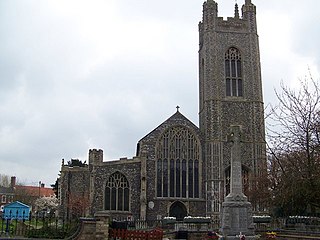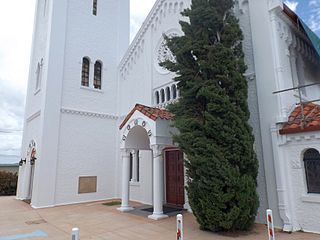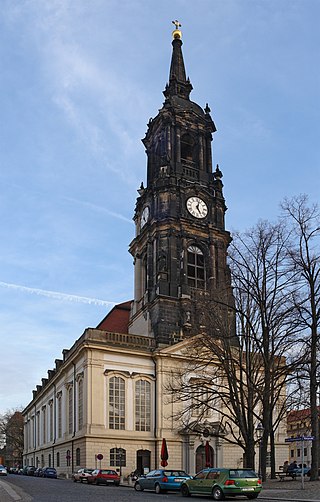
St Dunstan-in-the-East was a Church of England parish church on St Dunstan's Hill, halfway between London Bridge and the Tower of London in the City of London. The church was largely destroyed in the Second World War and the ruins are now a public garden.

Christ Church Greyfriars, also known as Christ Church Newgate Street, was a church in Newgate Street, opposite St Paul's Cathedral in the City of London. Established as a monastic church in the thirteenth century, it became a parish church after the Dissolution of the Monasteries. Following its destruction in the Great Fire of London of 1666, it was rebuilt to the designs of Sir Christopher Wren. Except for the tower, the church was largely destroyed by bombing during the Second World War. The decision was made not to rebuild the church; the ruins are now a public garden.

Beachamwell is a village and civil parish in the Breckland district of Norfolk, England about 5 miles (8.0 km) south west of Swaffham and 10 miles (16 km) east of Downham Market. It has four ancient churches, two of them in ruins. The former parish of Shingham has been annexed.

The Church of St. Nicholas was a Gothic Revival cathedral that was formerly one of the five Lutheran Hauptkirchen in the city of Hamburg, Germany. The original chapel, a wooden building, was completed in 1195. It was replaced by a brick church in the 14th century, which was eventually destroyed by fire in 1842. The church was completely rebuilt by 1874, and was the tallest building in the world from 1874 to 1876. It was designed by the English architect George Gilbert Scott.

Maulden is a village and civil parish located in the county of Bedfordshire. The village is located 1.5 miles east of Ampthill and about 8 miles (13 km) south of Bedford. It has about 1,250 homes and 3130 residents.

St James Garlickhythe is a Church of England parish church in Vintry ward of the City of London, nicknamed "Wren's lantern" owing to its profusion of windows.

The Sophienkirche was a church in Dresden.

Trinity Episcopal Church is a historic church in Mobile, Alabama, United States. It was the first large Gothic Revival church built in Alabama. The building was designed by architects Frank Wills and Henry Dudley.

Saint Michael's is a former Roman Catholic parish in Berlin, Germany, dedicated to the Archangel Michael. It is noted for its historic church in Mitte, near the border between Berlin-Mitte locality and Kreuzberg. The church was built between 1851 and 1861, and also served as a garrison church for Catholic soldiers. It was heavily damaged by bombing during the Second World War and partially reconstructed in the 1950s. It is protected as a historical monument in Berlin.

All Saints Church was an Anglican church on Wiener Straße in Dresden. It was in the Early English Period of Neo-Gothic architecture.

The Kaiserpalast was a five-storey neo-Baroque building in Dresden, which stood on the north side of the Pirnaischer Platz between Moritzring and Amalienstraße. It was built between 1895 and 1897 as the Geschäftshaus Ilgen by the architects Schilling und Graebner for the businessman Hermann Ilgen.

The Zionskirche is the name given to two Evangelical Lutheran church buildings in the Südvorstadt district of Dresden. The first, the Alte Zionskirche, was built by Schilling & Graebner from 1908 to 1912. This building was hit and badly damaged by fire during the bombing in February 1945. A temporary roof was later added and it is now preserved as a ruin, housing a lapidarium with 3000 sculptures. The parish, meanwhile, was housed in a barracks next to the ruins until the first stone of a new building, the Neue Zionskirche, was laid on Bayreuther Straße on 5 June 1981, as a gift from the Church of Sweden. With its construction overseen by Eberhard Burger, the new building was inaugurated on 31 October 1982.

St Mary's Church is a redundant Anglican church in the town of Bungay, Suffolk, England. The church and the ruins of the adjacent priory are recorded in the National Heritage List for England as a designated Grade I listed building, and are under the care of the Churches Conservation Trust. The church stands in the centre of the town on St Mary's Street, the A144 road.

Hohenrätien Castle is a castle in the municipality of Sils im Domleschg of the Canton of Graubünden in Switzerland. It is a Swiss heritage site of national significance.

Grace and Holy Trinity Cathedral is an Episcopal cathedral in the Quality Hill neighborhood of downtown Kansas City, Missouri, United States. It is the seat of the Episcopal Diocese of West Missouri.

Holy Trinity Anglican Church is a heritage-listed Anglican church at 68 Hawthorne Street, Woolloongabba, Brisbane, Queensland, Australia. Since 1869, three church buildings have stood on this hill top site. The current church was completed in 1930. It was designed by the architect Eric Ford, featuring Romanesque and Spanish Mission Revival style architecture. Its preserved original architectural features make the church a traditional wedding venue of inner Brisbane. The church was added to the Queensland Heritage Register on 9 May 2008.

St Bartholomew's Church, East Ham is a Church of England church on Barking Road in East Ham, east London dedicated to Bartholomew the Apostle.

The Dreikönigskirche is a Lutheran church located in the Innere Neustadt of Dresden, Germany. It is the centre of a parish, and a community venue called Haus der Kirche. The church is a listed cultural monument of Dresden.
The Loschwitz Church is a baroque church in the Loschwitz district of Dresden. It was the first church built by the architect of the Dresden Frauenkirche, George Bähr. The churchyard, which was used as a cemetery until 1907, is one of the few 18th-century churchyards in Saxony that is still in its original state and is the smallest cemetery in the city at about 400 square meters. The Loschwitz church and cemetery are under monument protection.


















